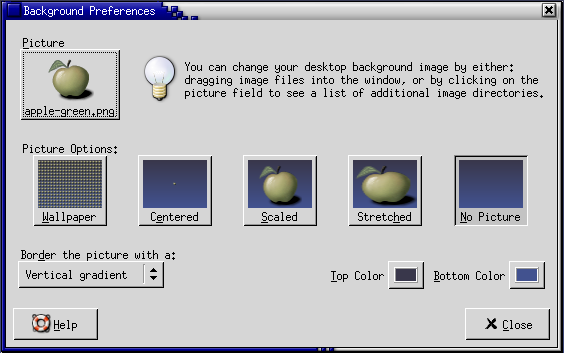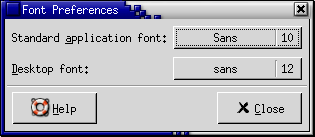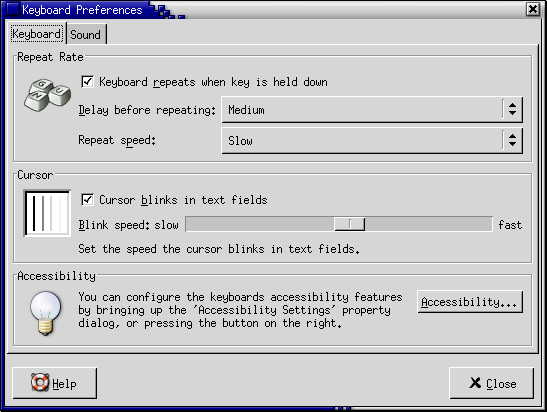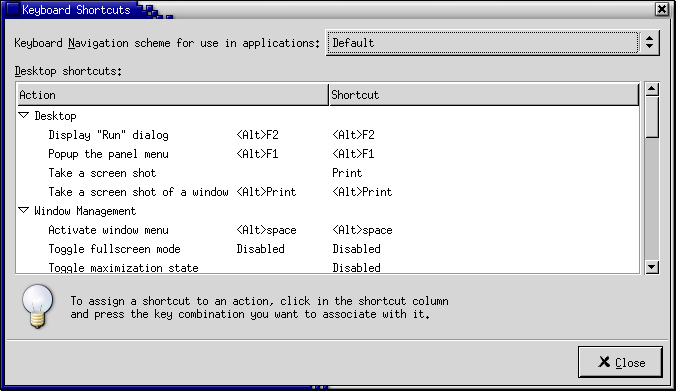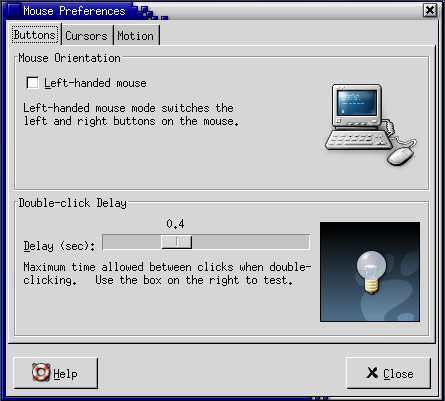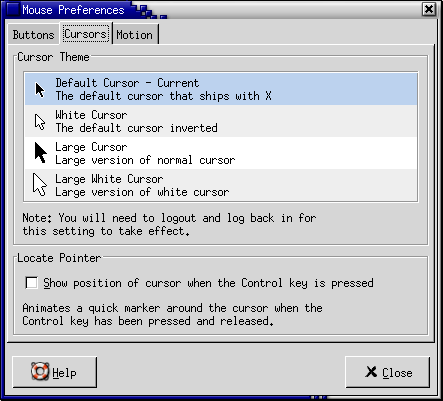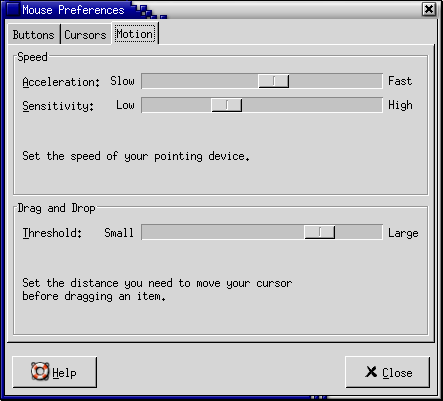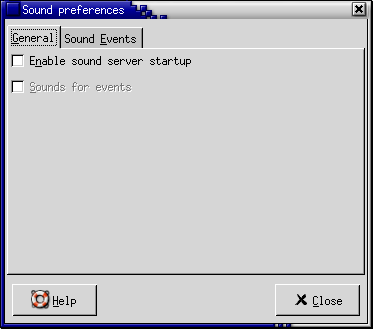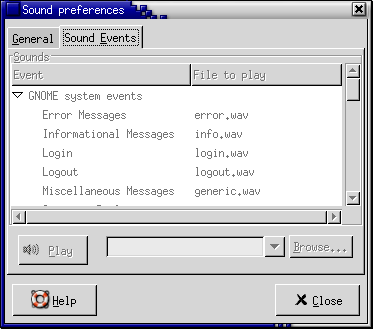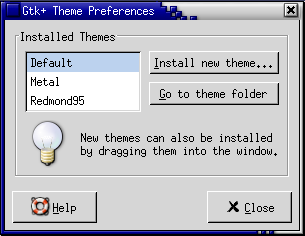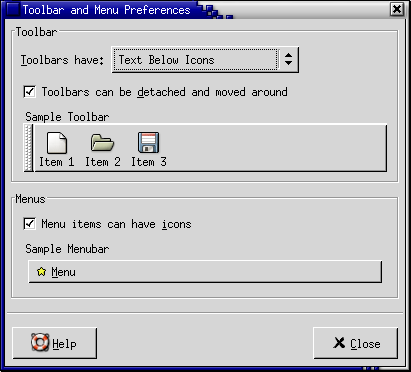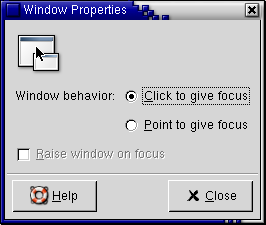Using the Basic Preference Tools
The basic preference tools enable you to customize your desktop background. You can use the basic preference tools to configure your keyboard settings and your mouse settings. You can also use the basic preference tools to configure shortcut keys, and to set your sound preferences. This chapter describes how to use the basic preference tools to customize your desktop.
- II.9.1. Opening a Basic Preference Tool
- II.9.2. Customizing the Desktop Background
- II.9.3. Choosing Default Fonts
- II.9.4. Configuring Keyboard Settings
- II.9.5. Customizing Shortcut Keys
- II.9.6. Configuring Mouse Settings
- II.9.7. Configuring Network Settings
- II.9.8. Setting Sound Preferences
- II.9.9. Setting Themes in the Desktop
- II.9.10. Customizing Toolbars and Menus
- II.9.11. Customizing Window Focus
II.9.1. Opening a Basic Preference Tool
You can open one of the basic preference tools in either of the following ways:
-
From the menu
Choose . Choose the preference tool that you require from the submenu. The dialog for the tool is displayed.
-
From the Start Here location
Open a Nautilus window, then choose . Alternatively, double-click on the Start Here object on the desktop background. The Start Here location is displayed. Double-click on the Preferences object in the Nautilus window to display your preference tools, as shown in the following figure:
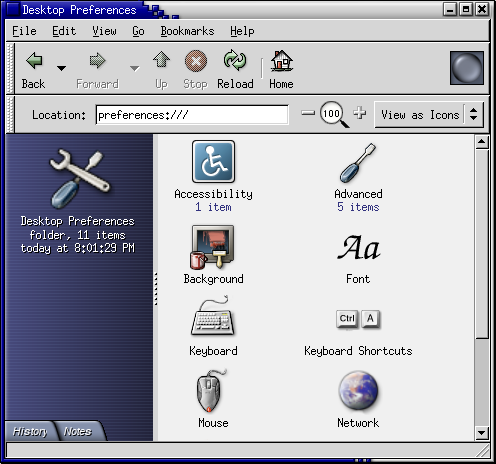
Double-click on the tool that you require. The dialog for the tool is displayed.
II.9.2. Customizing the Desktop Background
The desktop background is the part of the desktop where there are no interface graphical items, such as panels and windows. The desktop background is always beneath the other interface items.
You can customize the desktop background in the following ways:
- Select an image to display on the desktop background. The image is superimposed on the desktop background color. The desktop background color is visible if you select a transparent image, or if the image does not cover the entire desktop background.
- Select a color for the desktop background. You can select a solid color, or create a gradient effect with two colors. A gradient effect is a visual effect where one color blends gradually into another color.
You can also change the appearance of your desktop background from within the Nautilus file manager.
Table II.9-1 lists the background settings that you can configure.
| Element | Function |
|---|---|
| Picture | Choose an image to display on the desktop background. To choose an image, click on the button. An image selector dialog is displayed. Choose an image from the dialog. Alternatively, to choose an image from another directory, click . When you choose an image, click . |
| Picture Options |
To specify how to display the image, select one of the following options:
|
| Border the picture with a |
To specify a color scheme, use the options in the Border the picture with a drop-down list box, and the color selector buttons. You can specify a color scheme in one of the following ways:
|
II.9.3. Choosing Default Fonts
Use the Font preference tool to specify the fonts to use on your desktop.
Table II.9-2 lists the font settings that you can configure for the desktop.
II.9.4. Configuring Keyboard Settings
Use the Keyboard preference tool to specify the autorepeat settings for your keyboard, and to configure the sound events that are associated with the keyboard.
You can customize the settings for the Keyboard preference tool in the following functional areas:
- Keyboard
- Sound
- II.9.4.1. Keyboard Settings
- II.9.4.2. Sound Settings
II.9.4.1. Keyboard Settings
Use the Keyboard tabbed section to specify general keyboard preferences.
Table II.9-3 lists the keyboard settings that you can configure.
| Option | Function |
|---|---|
| Keyboard repeats when key is held down | Select this option to enable keyboard repeat. If keyboard repeat is enabled, when you press-and-hold a key, the action associated with the key is performed repeatedly. For example, if you press-and-hold a character key, the character is typed repeatedly. |
| Delay before repeating | Select the delay from the time you press a key to the time that the action repeats. |
| Repeat speed | Select the speed at which the action is repeated. |
| Cursor blinks in text fields | Select this option to enable the cursor to blink in fields and text boxes. |
| Blink speed | Use the slider to specify the speed at which the cursor blinks in fields and text boxes. |
| Click on this button to start the AccessX preference tool. |
II.9.4.2. Sound Settings
Use the Sound tabbed section to specify your preferences for keyboard sound.
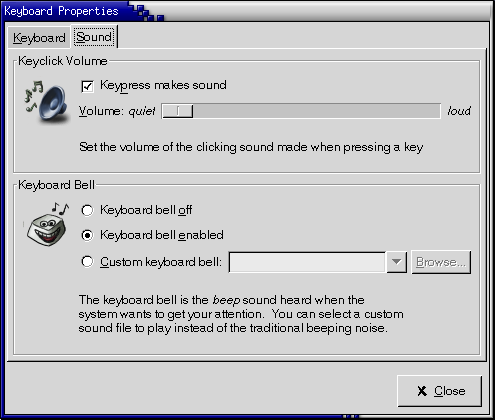
Table II.9-4 lists the keyboard sound settings that you can configure.
| Option | Function |
|---|---|
| Keypress makes sound | Select this option to enable a click sound when you press a key. |
| Volume | Use the slider to specify the volume at which to play the key click sound. |
| Keyboard Bell |
Some applications play a bell sound to indicate a keyboard input error. Use the options in the Keyboard Bell group to configure the bell sound.
|
II.9.5. Customizing Shortcut Keys
Shortcut keys enable you to use the keyboard to perform tasks in the desktop and in applications.
Use the Keyboard Shortcuts preference tool to display the default shortcut keys. You can customize the default shortcut keys to your requirements.
Table II.9-5 lists the shortcut key settings that you can customize.
| Option | Function |
|---|---|
| Keyboard Navigation scheme for use in applications |
Select one of the following settings:
|
| Desktop Shortcuts |
This table displays the shortcut key settings. The actions are listed with their key combinations. Use this table to display your shortcut key settings. To customize a shortcut key, double-click in the shortcut column for the function you want to change. Press the key combination that you want to associate with the function you want to change. To disable a shortcut key, double-click in the shortcut column for the function you want to change, then press Back Space. |
II.9.6. Configuring Mouse Settings
Use the Mouse preference tool to configure your mouse for right–hand use or for left-hand use. You can also specify the speed and sensitivity of mouse movement.
You can customize the settings for the Mouse preference tool in the following functional areas:
- Buttons
- Cursors
- Motion
- II.9.6.1. Buttons Settings
- II.9.6.2. Pointer Settings
- II.9.6.3. Motion Settings
II.9.6.1. Buttons Settings
Use the Buttons tabbed section to specify whether the mouse buttons are configured for left-hand use. You can also specify the delay between clicks for a double-click.
Table II.9-6 lists the mouse button settings that you can configure.
| Option | Function |
|---|---|
| Left-handed mouse | Select this option to configure your mouse for left hand use. When you configure your mouse for left hand use, the functions of the left and right mouse buttons are swapped. |
| Delay | Use the slider to specify the amount of time that can pass between clicks when you double-click a mouse button. If the interval between the first and second clicks exceeds the time that is specified here, the action is not interpreted as a double-click. |
II.9.6.2. Pointer Settings
Use the Cursors tabbed section to set your mouse pointer preferences.
Table II.9-7 lists the mouse pointer settings that you can configure:
| Option | Function |
|---|---|
| Cursor Theme | Select the mouse pointer theme that you require from the list box. |
| Show position of cursor when the Control key is pressed | Select this option to enable a mouse pointer animation when you press Ctrl. This feature can assist you to locate the mouse pointer on your desktop. |
II.9.6.3. Motion Settings
Use the Motion tabbed section to set your preferences for mouse movement.
Table II.9-8 lists the mouse motion settings that you can configure:
| Setting | Function |
|---|---|
| Acceleration | Use the slider to specify the speed at which your mouse pointer moves on your screen when you move your mouse. |
| Sensitivity | Use the slider to specify how sensitive your mouse pointer is to movements of your mouse. |
| Threshold | Use the slider to specify the distance that you must move an item before the move action is interpreted as a drag-and-drop action. |
II.9.7. Configuring Network Settings
The Network preference tool enables you to configure how your desktop connects to networks. You can configure the desktop to connect to a proxy server, and specify the details of the proxy server.
Table II.9-9 lists the network settings that you can configure.
| Option | Function |
|---|---|
| Use HTTP Proxy | Select this option to use a proxy server for the HTTP service. |
| Location | Enter the DNS name, or the IP address of the proxy server to use when you request a HTTP service. |
| Port | Enter the port number of the HTTP service on the proxy server. |
| Proxy requires a username and password | Select this option if the proxy server requires a username and password. |
| Username | Enter the username for the proxy server. |
| Password | Enter the password for the proxy server. |
II.9.8. Setting Sound Preferences
The Sound preference tool enables you to control when the GNOME sound engine starts. You can also specify which sounds to play when particular events occur.
You can customize the settings for the Sound preference tool in the following functional areas.
- General
- Sound Events
- II.9.8.1. General Settings
- II.9.8.2. Sound Event Settings
II.9.8.1. General Settings
Use the General tabbed section of the Sound preference tool to specify when to launch the GNOME sound engine. You can also enable sound event functions.
Table II.9-10 lists the general sound settings that you can configure.
| Option | Function |
|---|---|
| Enable sound server startup | Select this option to start the GNOME sound engine when you start a GNOME session. When the sound engine is active, the desktop can play sounds. |
| Sounds for events | Select this option to play sounds when particular events occur in your desktop. You can select this option only if the Enable sound server startup option is selected. |
II.9.8.2. Sound Event Settings
Use the Sound Events tabbed section of the Sound preference tool to associate particular sounds with particular events.
You must select the Enable sound server startup option, and the Sounds for events option before you can access the Sound Events tabbed section.
Table II.9-11 lists the sound events settings that you can configure.
| Option | Function |
|---|---|
| Sounds table |
Use the Sounds table to associate particular sounds with particular events. The Event column displays a hierarchical list of events that can occur. To expand a category of events, click on the right arrow beside a category of events. The File to play column lists the sound file that plays when the event occurs. |
| Click on this button to play the sound file that is associated with the selected event. | |
| Sound file drop-down combination box, |
Enter the name of the sound file that you want to associated with the selected event in the drop-down combination box. Alternatively, click to display a Select sound file dialog. Use the dialog to specify the sound file that you want to associate with the selected event. You can only associate sound files in .wav format with events. |
II.9.9. Setting Themes in the Desktop
A theme is a group of coordinated settings that specify the visual appearance of a part of your interface. Use the Theme preference tool to select a theme for your desktop.
Your desktop theme specifies the visual appearance of your panels, applets, and windows. The desktop theme also specifies the appearance of GNOME-compliant application interface items. For example, the theme affects the appearance of buttons, scrollbars, check boxes, and so on.
You can choose from the list of available themes, or you can install new themes.
Table II.9-12 lists the theme settings that you can configure.
II.9.10. Customizing Toolbars and Menus
You can use the Toolbars & Menus preference tool to customize the appearance of menus, menubars, and toolbars for GNOME-compliant applications.
Table II.9-13 lists the toolbar and menu settings that you can customize for GNOME-compliant applications.
| Option | Function |
|---|---|
| Toolbars have |
Choose one of the following options to specify what to display on the toolbars in your GNOME-compliant applications:
|
| Toolbars can be detached and moved around | Select this option if you want to move toolbars from application windows to any location on the desktop. If you select this option, handles are displayed on the left side of the toolbars in your applications. To move a toolbar, click-and-hold on the handle, then drag the toolbar to the new location on the desktop. |
| Menu items have icons | Select this option to display an icon beside each item in a menu. Some menu items do not have an icon. |
II.9.11. Customizing Window Focus
Use the Window Behavior preference tool to customize window focus behavior for your desktop.
Table II.9-14 lists the window focus settings that you can customize.
| Option | Function |
|---|---|
| Click to give focus | Select this option to give focus to a window when you click on the window. The window retains focus until you click on another window. |
| Point to give focus | Select this option to give focus to a window when you point to the window. The window retains focus until you point to another window. |
| Raise window on focus | Select this option if you want your windows to be raised when the windows receive focus. |
